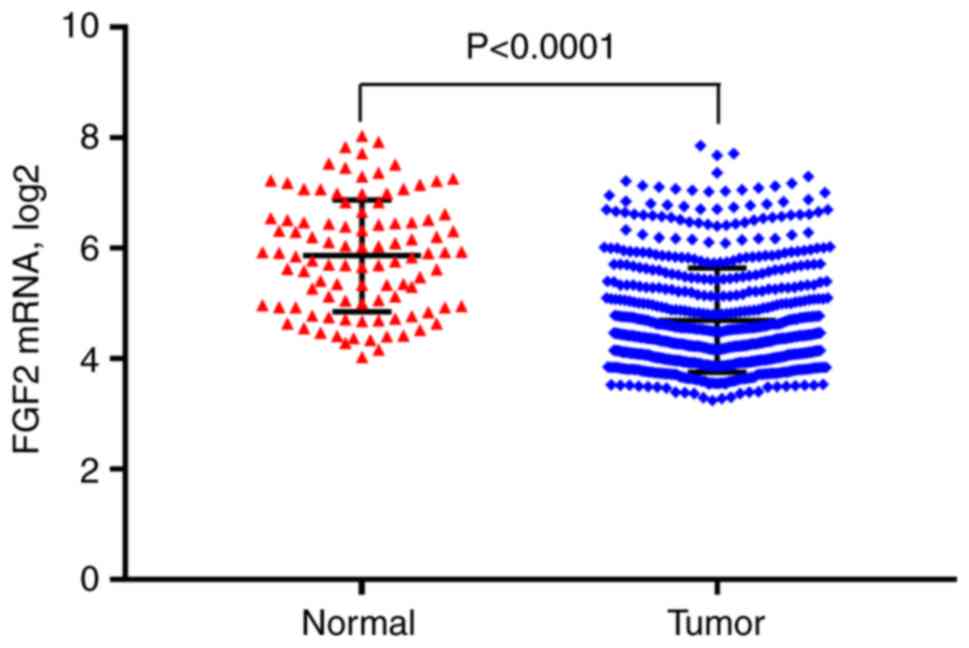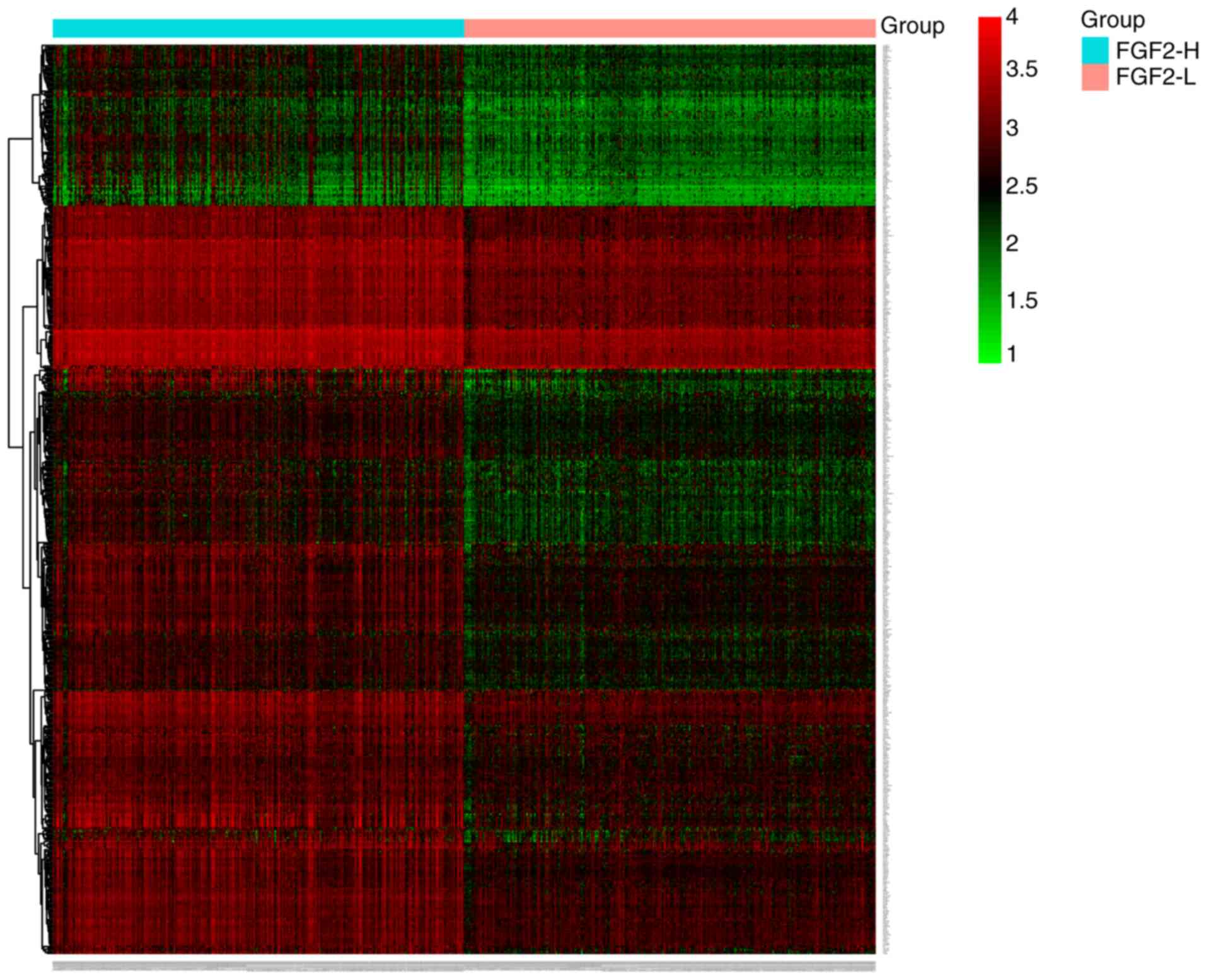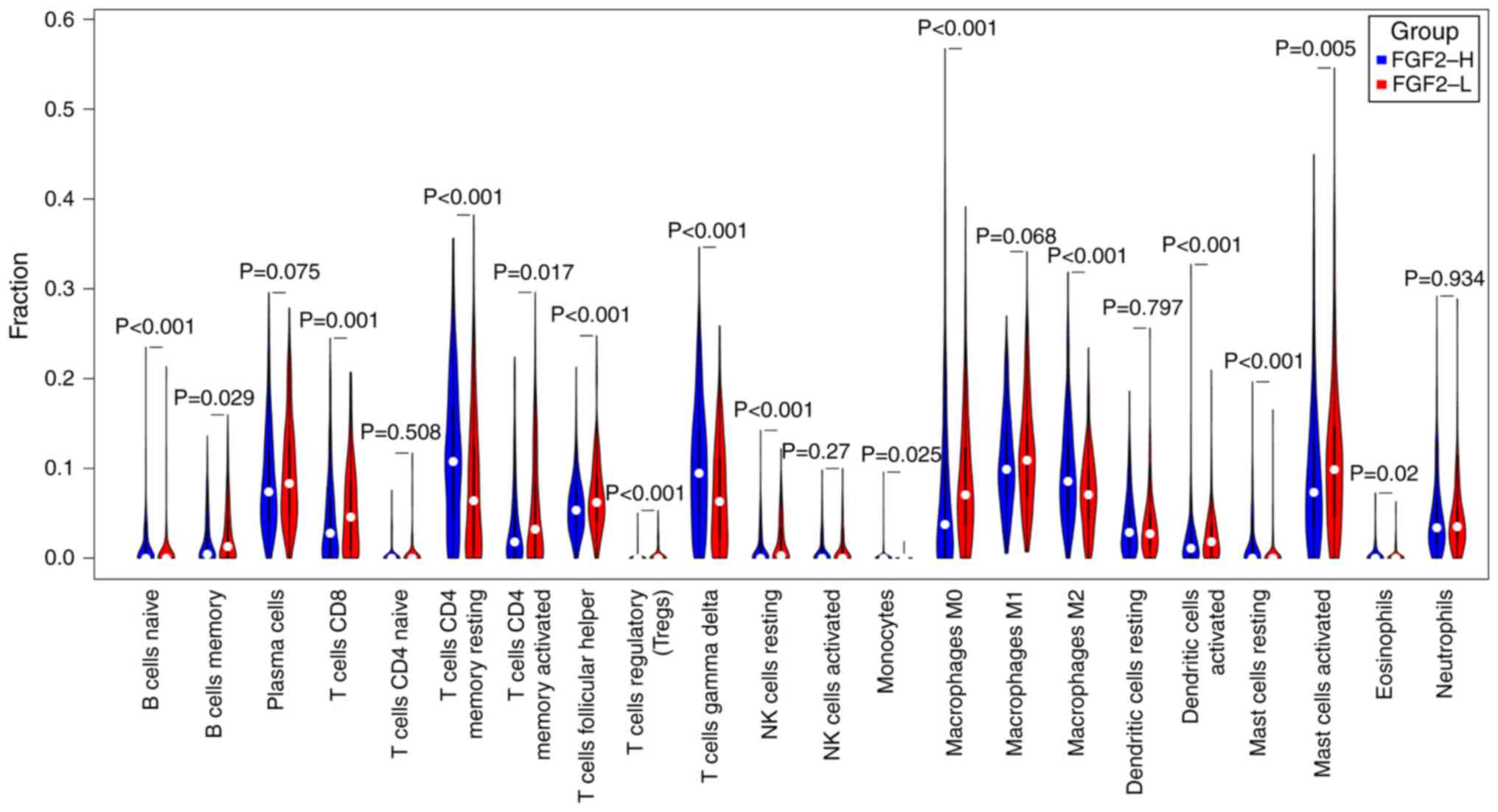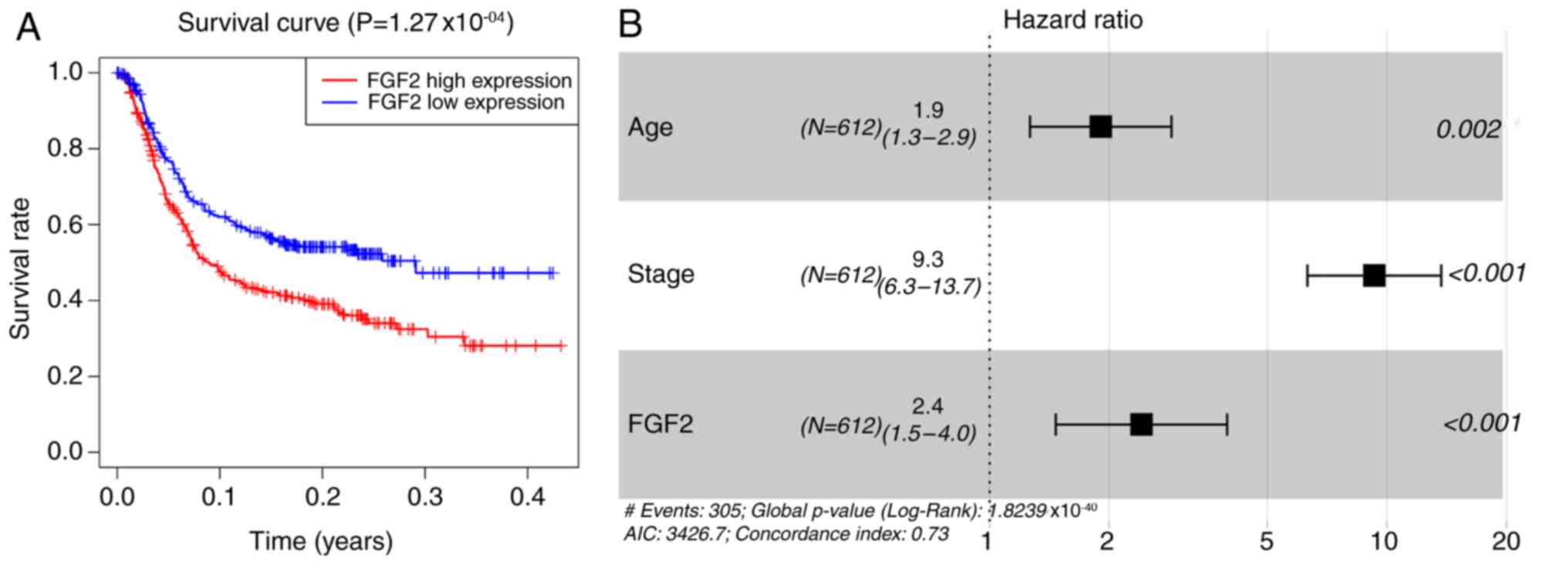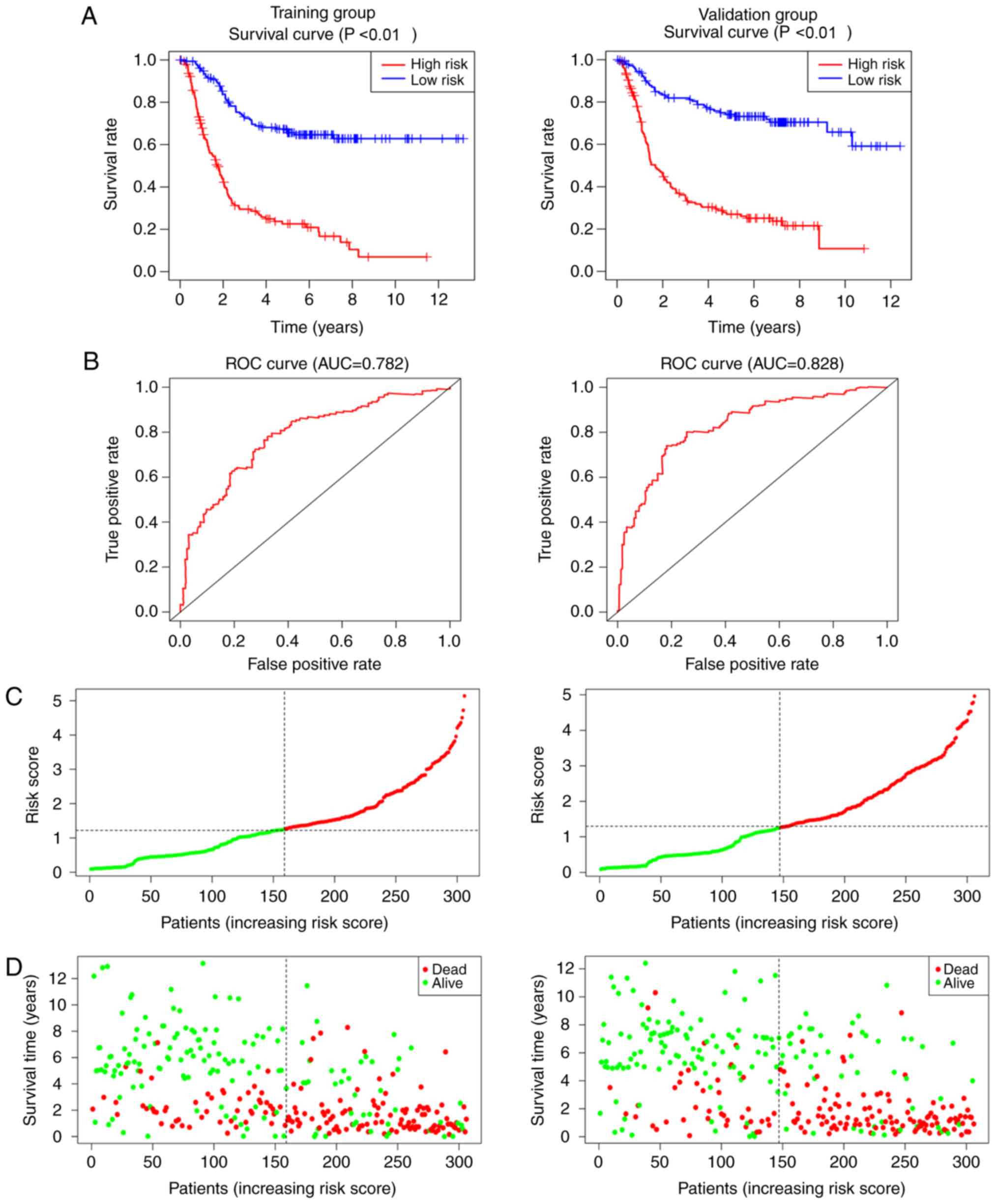Introduction
Gastric cancer (GC) is a common malignant tumor with
the fourth-highest occurrence among different types of cancer, and
it is the third leading cause of death worldwide (1,2).
Even following diagnosis at an early stage, where endoscopic
mucosal resection or endoscopic submucosal dissection are
successfully performed, the recurrence rate and prognosis are
unsatisfactory (3). Incomplete
assessment or resection can lead to the local recurrence and worse
prognosis. In addition, various factors, including angiogenesis and
tumor cell adhesion, are associated with the development of GC
(4,5). Therefore, it is important to identify
novel diagnostic and prognostic markers for guiding or assessing
the treatment of GC. In addition, transcriptome analysis using
microarray and RNA sequencing has been previously shown to be an
effective method to identify biomarkers (6,7).
As a member of the fibroblast growth factor (FGF)
family, FGF2 has important roles in angiogenesis, the regulation of
extracellular matrix, cell differentiation and inflammatory
responses, thereby contributing to the development, progression and
pathogenesis of tumors (8–10). FGF2 has been reported to mediate
cell migration and invasion in breast cancer, pancreatic cancer,
astrocytes and gliomas (11–14).
however, whether FGF2 has a role in the occurrence and development
of GC remains unclear. In the present study, microarray data from
patients with GC from Gene Expression Omnibus (GEO) databases were
analyzed in order to investigate the function of FGF2 in GC.
Materials and methods
Microarray data collection
To identify GC data sets with relevant clinical
information, systematic searches of GEO datasets (https://www.ncbi.nlm.nih.gov/geo/) were
conducted. The inclusion criteria for the datasets were as follows:
i) Sample size >50; ii) the studies presented relevant clinical
information; and iii) datasets were generated using Affymetrix
Human Genome 133 plus 2.0 Gene Chips (Affymetrix; Thermo Fisher
Scientific, Inc.). In total, four data sets, GSE66229 (Cristescu
et al, 2015) (n=400) (15),
GSE15459 (Ooi et al, 2009) (n=200) (16), GSE57303 (Qian et al, 2014)
(n=70) (17) and GSE34942 (Lei
et al, 2012) (n=56) (18),
were selected for further analysis. The batch function of SVA
package (3.32.1 version) (https://bioconductor.org/packages/release/bioc/html/sva.html)
was used to consolidate the 4 data sets. Data normalization was
performed by R software (3.6.0 version; http://cran.r-project.org/) and gene expression levels
were computed as mean values of all annotated probe sets (19).
Analysis of correlation between FGF2
expression and clinical characteristics
The mRNA expression levels of FGF2 between tumor
(n=626) and normal tissues (n=100) were compared. Both the median
and the receiver operating characteristic (ROC) curve can be used
as the grouping criteria. Due to the difference in the sample size
between the groups, the median expression of FGF2 was selected to
replace the ROC curve as the grouping standard. According to the
median expression of FGF2, 612 patients, whose clinical information
was available, were equally divided into two groups: An FGF2-high
expression group (FGF2-H) and an FGF2-low expression group
(FGF2-L). Differentially expressed genes [P<0.05, and |log fold
change (FC)|≥1)] were identified between the two groups and
analyzed using Gene Ontology (GO) and Kyoto Encyclopedia of Genes
and Genomes (KEGG) using DAVID 6.8 (https://david.ncifcrf.gov/) (20). Clinical characteristics, including
patient age, gender, tumor stage, Lauren classification (21), the extent of immune infiltration
and overall survival (OS), were collected in order to identify
correlations regarding FGF2 expression and clinical
characteristics. The CIBERSORT (https://cibersort.stanford.edu/) method and the LM22
gene signature were used for immune infiltration analysis (22). All results were considered
statistically significant at a threshold of P<0.05.
Construction of a clinical prognosis
model
A Cox-prognosis model was constructed using R
software (3.6.0 version). R packages including survival (version
2.44–1.1; http://github.com/therneau/survival), survminer
(version 0.4.5; http://www.sthda.com/english/rpkgs/survminer/),
survivalROC (contained in survcomp package; version 1.34.0;
http://git.bioconductor.org/packages/survcomp) and
survcomp (version 1.34.0; http://git.bioconductor.org/packages/survcomp) were
used for the model and the calculation of C-index. In total, 612
patients with clinical information were randomly divided into two
groups: A training group (n=306) and a validation group (n=306).
The risk score for each patient was calculated based on the
independent factors identified by the multivariate Cox model. The
prognosis for each patient was evaluated according to risk scores.
The sensitivity and specificity of the model were described using a
time-dependent ROC curve (23).
Statistical analysis
Statistical analysis was performed using R software
and SPSS version 23.0 (IBM Crop.). Graphical representations were
generated using GraphPad Prism 7 (GraphPad Software, Inc.).
χ2 and Wilcoxon rank-sum tests were used for categorical
and continuous variables, respectively. Multivariate Cox
proportional-hazards analysis was used for identifying independent
prognostic factors.
Results
Differential gene expression
In total, four GEO datasets were extracted and
normalized to analyze the expression patterns of FGF2 in GC.
Compared with normal tissues, FGF2 mRNA expression levels were
lower in GC (P<0.0001; Fig. 1).
A total of 536 differentially expressed genes in the FGF2-H and
FGF2-L cohorts were identified by R software and the results were
analyzed using GO and KEGG (Fig. 2
and Table SI). GO analysis
results revealed that the differentially expressed genes were
predominantly involved in the regulation of ‘extracellular matrix
organization’, ‘cell adhesion’ and ‘angiogenesis’ (Fig. 3A). KEGG analysis results revealed
that the genes identified were predominantly involved in ‘focal
adhesion’, ‘ECM-receptor interaction’ and the ‘cGMP-PKG signaling
pathway’ (Fig. 3B). The biological
functions and signaling pathways associated with these genes were
closely related to the development of GC.
Association of FGF2 expression with
clinical characteristics
In total, 612 patients with clinical data were
selected, and an association analysis of the FGF2 expression levels
and clinical characteristics was performed. The patients were
divided to the FGF2-H and FGF2-L groups, according to the median
FGF2 expression. As listed in Table
I, the patient age in the FGF2-L group was higher compared with
that in the FGF2-H group. A statistical significance was found
between stages II and IV (P<0.001; Table I), therefore, for further
comparison, stages I and II were classified as early-stage and
stages III and IV as advanced. The FGF2-H group had more patients
with advanced-stage tumors compared with the FGF2-L group
(P<0.001; Table I). Classifying
the patient samples according to Lauren's criteria, a difference
was observed in diffuse and intestinal types, but no difference was
observed for the mixed types. In total, 366 patients were selected
with detailed TNM staging in the four datasets for further
analysis. There was a significant difference between the two
FGF2-expressing groups in the T2 and T3 stages. Compared with
FGF2-L, the number of patients with advanced-stage GC (T3 and T4)
in the FGF2-H group was higher compared with the FGF2-L group
(P<0.001; Table I). No
significant difference was observed when comparing the N and M
scores of the two FGF2-expressing groups (Table I).
 | Table I.Clinical characteristics and
association with FGF2 expression. |
Table I.
Clinical characteristics and
association with FGF2 expression.
|
| FGF2-H group | FGF2-L group | P-value |
|---|
| Age (n=612) |
|
| 0.0043 |
|
≥60 | 191 | 224 |
|
|
<60 | 115 | 82 |
|
| Sex (n=612) |
|
| 0.1227 |
|
Female | 111 | 93 |
|
|
Male | 195 | 213 |
|
| TNM stage
(n=612) |
|
|
|
| I | 25 | 50 | 0.0021 |
| II | 55 | 90 | 0.0009 |
|
III | 125 | 102 | 0.4706 |
| IV | 101 | 64 | 0.0008 |
|
I+II/III+IV | 80/226 | 140/166 | <0.0001 |
| Lauren (n=612) |
|
|
|
|
Diffuse | 165 | 90 | <0.0001 |
|
Intestinal | 114 | 189 | <0.0001 |
|
Mixed | 27 | 27 | 1.0000 |
| T (n=366) |
|
|
|
| T1 | 0 | 0 | 1.0000 |
| T2 | 64 | 130 | <0.0001 |
| T3 | 103 | 39 | <0.0001 |
| T4 | 16 | 14 | 0.7031 |
|
T1+2/T3+4 | 64/119 | 130/53 | <0.0001 |
| N (n=366) |
|
|
|
| N0 | 27 | 24 | 0.6507 |
| N1 | 70 | 86 | 0.0908 |
| N2 | 55 | 50 | 0.5634 |
| N3 | 31 | 23 | 0.2384 |
|
N0+1/N2+3 | 97/86 | 110/73 | 0.1704 |
| M (n=366) |
|
| 0.1497 |
| M0 | 162 | 170 |
|
| M1 | 21 | 13 |
|
Comparison of immune cell type
fractions
Patients with P>0.05 were removed following
CIBERSORT calculations (n=584; FGF2-H=301, FGF2-L=283), and
non-parametric testing was used for comparison of the immune cell
fractions (Figs. 4 and 5). The results revealed significant
differences among the abundance of various immune cells, including
CD4+ T cells, T regulatory cells, γδ T cells,
macrophages, dendritic cells and mast cells (P<0.05).
High FGF2 expression predicts poorer
OS in patients with GC
Since FGF2 has a role in cell adhesion and because
significant differences were identified in the abundance of
different immune cell types in the tumor tissues, the survival of
patients with GC may be affected by FGF2 expression levels. As
shown in Fig. 6A, there was a
strong association between higher FGF2 expression and shorter OS in
patients with GC. Using multivariate analysis, FGF2 levels, age and
tumor staging, were demonstrated to be independent prognostic
indicators (Fig. 6B).
Clinical prognosis model with
independent values
The risk score for each patient in the training
group (n=306) and the validation group (n=306) was calculated based
on the three independent factors, FGF2 levels, age and tumor
staging, as identified by the multivariate Cox model (Fig. 6B). The survival analysis revealed
that patients with low-risk scores had longer survival times in
both the training and validation groups (P<0.001; Fig. 7A). ROC curves for the prognosis
model were plotted, and the area under the curve was 78.2% in the
training group and 82.8% in the validation group (Fig. 7B). The C-index was 0.725 in the
training group [Hazard ratio (HR), 0.688–0.761; P<0.001] and
0.733 in the validation group (HR, 0.695–0.771; P<0.001). The
results of the risk score and status plots (Fig. 7C and D) were consistent, and the
accuracy and feasibility of the model were verified.
Discussion
GC is a common malignant tumor, with complex factors
leading to high mortality and low 5-year survival rates. With
technological developments, chromatin immunoprecipitation and
sequencing technologies have improved, and increasing numbers of
studies are now being conducted to understand in-depth the
molecular mechanisms involved in GC (24).
FGF2 is a member of the FGF family and has important
roles in various biological processes, such as angiogenesis, the
regulation of the extracellular matrix, epithelial cell
differentiation and inflammatory responses (8–10).
In normal tissues, FGF2 promotes endothelial cell migration, smooth
muscle proliferation and induces hematopoiesis (25,26).
however, in tumor tissues, the roles of FGF2 in promoting
angiogenesis and regulating cell adhesion may contribute to tumor
progression (8–10). Previous studies have demonstrated
that FGF2 activates cell proliferation and invasion through the
PI3K/AKT, ERK or mitogen-activated protein kinase signaling
pathways in esophageal, ovarian and breast cancers (27–29).
Therefore, FGF2 serves important roles in the occurrence and
development of tumors, and is closely associated with the
activation of multiple signaling pathways. However, the role of
FGF2 in the occurrence and prognosis of GC is not clear.
In the present study, the expression of FGF2 was
higher in normal tissues compared with tumor tissues. Although the
expression of FGF2 was found to be higher in normal tissues, the
expression of FGF2 was identified to be associated with worse TNM
staging using GEPIA; suggesting the need of further research to
investigate the role of FGF2 in tumor. TNM stage is a significant
prognostic factor in tumor progression (30,31).
A comparison between FGF2-H and FGF2-L groups revealed more
patients with advanced TNM staging, especially T stage, in the
FGF2-H group. Previous studies have shown that FGF2, by promoting
angiogenesis, allows gastric tumor cells to receive abundant
nutrient supplies, thereby inducing a greater degree of tumor cell
infiltration (8–10). In terms of N and M stages, though
no significant differences were observed between the two groups in
the present study, it was evident that the number of patients
staged as N2 and N3 were higher in the FGF2-H group compared with
the FGF2-L group. Similar results for the M stage of patients with
GC were observed, indicating that FGF2 may affect to some extent
the local and distant metastasis in GC. Further analysis involving
a larger number of patients is required to confirm these
observations.
In the present study, tumor immune infiltration was
also evaluated, another important characteristic of GC. The degree
of immune cell infiltration has different effects on tumor
prognosis and has been studied previously (32–36).
Preliminary analysis of the immune infiltration was conducted, no
further analysis was performed as the main functional enrichment of
genes in the FGF2-H and FGF2-L groups did not identify immune
associated genes.
In the present study, there were significant
differences in the proportion of CD4+ T-cells, M2
macrophages, mast cells and dendritic cells between the two groups.
Specifically, the FGF2-H group had significantly higher proportions
of resting CD4+ memory cells, γδ T cells, M2 macrophages
and natural killer resting cells compared with the FGF2-L group,
while the proportion of plasma cells, activated CD4+
memory cells, M0 macrophages and activated dendritic cells was
lower than in the FGF2-L group. Previous studies have reported a
negative correlation between the degree of infiltration of
dendritic cells, tumor progression and metastasis (37,38).
Therefore, the higher the number of dendritic cells, the more
positive the prognosis for the patient. M2 macrophages are
hypothesized to promote tumor growth, infiltration and metastasis,
and their degree of infiltration is negatively correlated with the
prognosis of patients (39,40).
CD4+ T cells are important for the protection against
cancer (41). In the present
study, patients in the FGF2-L group had more dendritic cells,
CD4+ memory activated T cells, fewer M2 cells, and a
higher survival rate. These findings are consistent with the
hypothesis that FGF2 may influence the prognosis of GC.
Using multivariate regression analysis, it was found
that the survival time of patients in the FGF2-L group was
significantly improved compared with the FGF2-H group. Age, TNM
stage and FGF2 expression were independent factors for GC. With the
construction of a Cox risk model, the clinical prognosis of
patients was determined using their risk scores. For the training
and validation groups, the ROC curves were 0.78 and 0.82,
respectively, indicating the high accuracy of the current model.
Additionally, patients with higher risk scores had poorer survival
rates.
In summary, FGF2 levels may have an important role
in the development of GC and may serve as an independent factor to
evaluate the prognosis of patients with GC. Further studies,
increasing the sample size and using verified clinical data, are
essential to understand the molecular mechanisms involved in the
prognosis of GC.
Supplementary Material
Supporting Data
Acknowledgements
Not applicable.
Funding
The present study was supported by the National
Natural Science Foundation of China (General Program; grant no.
81572355).
Availability of data and materials
The datasets used and/or analyzed during the current
study are available from the GEO database.
Authors' contributions
YL and LL analyzed the data and drafted the
manuscript. XG and JW evaluated and interpreted the data
critically. XG, JW and HW evaluated and interpreted the data
critically. LL revised and approved the final version of the
manuscript. All authors critically revised the manuscript, and read
and approved the final version of the manuscript.
Ethics approval and consent to
participate
Not applicable.
Patient consent for publication
Not applicable.
Competing interests
The authors declare that they have no competing
interests.
References
|
1
|
Ferlay J, Soerjomataram I, Dikshit R, Eser
S, Mathers C, Rebelo M, Parkin DM, Forman D and Bray F: Cancer
incidence and mortality worldwide: Sources, methods and major
patterns in GLOBOCAN 2012. Int J Cancer. 136:E359–E386. 2015.
View Article : Google Scholar : PubMed/NCBI
|
|
2
|
Jung KW, Won YJ, Kong HJ, Oh CM, Shin A
and Lee JS: Survival of korean adult cancer patients by stage at
diagnosis, 2006–2010: National cancer registry study. Cancer Res
Treat. 45:162–171. 2013. View Article : Google Scholar : PubMed/NCBI
|
|
3
|
Lee JY, Cho KB, Kim ES, Park KS, Lee YJ,
Lee YS, Jang BK, Chung WJ and Hwang JS: Risk factors for local
recurrence after en bloc endoscopic submucosal dissection for early
gastric cancer. World J Gastrointest Endosc. 8:330–337. 2016.
View Article : Google Scholar : PubMed/NCBI
|
|
4
|
Lu Y, Xu Q, Zuo Y, Liu L, Liu S, Chen L,
Wang K, Lei Y, Zhao X and Li Y: Isoprenaline/β2-AR activates
plexin-A1/VEGFR2 signals via VEGF secretion in gastric cancer cells
to promote tumor angiogenesis. BMC Cancer. 17:8752017. View Article : Google Scholar : PubMed/NCBI
|
|
5
|
Xie M, Dart DA, Guo T, Xing XF, Cheng XJ,
Du H, Jiang WG, Wen XZ and Ji JF: MicroRNA-1 acts as a tumor
suppressor microRNA by inhibiting angiogenesis-related growth
factors in human gastric cancer. Gastric Cancer. 21:41–54. 2018.
View Article : Google Scholar : PubMed/NCBI
|
|
6
|
D'Angelo G, Di Rienzo T and Ojetti V:
Microarray analysis in gastric cancer: A review. World J
Gastroenterol. 20:11972–11976. 2014. View Article : Google Scholar : PubMed/NCBI
|
|
7
|
Hitzemann R, Bottomly D, Darakjian P,
Walter N, Iancu O, Searles R, Wilmot B and McWeeney S: Genes,
behavior and next-generation RNA sequencing. Genes Brain Behav.
12:1–12. 2013. View Article : Google Scholar : PubMed/NCBI
|
|
8
|
Moffett J, Kratz E, Florkiewicz R and
Stachowiak MK: Promoter regions involved in density-dependent
regulation of basic fibroblast growth factor gene expression in
human astrocytic cells. Proc Natl Acad Sci USA. 93:2470–2475. 1996.
View Article : Google Scholar : PubMed/NCBI
|
|
9
|
Coleman SJ, Chioni AM, Ghallab M, Anderson
RK, Lemoine NR, Kocher HM and Grose RP: Nuclear translocation of
FGFR1 and FGF2 in pancreatic stellate cells facilitates pancreatic
cancer cell invasion. EMBO Mol Med. 6:467–481. 2014. View Article : Google Scholar : PubMed/NCBI
|
|
10
|
Ren T, Qing Y, Dai N, Li M, Qian C, Yang
Y, Cheng Y, Li Z, Zhang S, Zhong Z and Wang D:
Apurinic/apyrimidinic endonuclease 1 induced upregulation of
fibroblast growth factor 2 and its receptor 3 induces angiogenesis
in human osteosarcoma cells. Cancer Sci. 105:186–194. 2014.
View Article : Google Scholar : PubMed/NCBI
|
|
11
|
Liu C, Guan H, Wang Y, Chen M, Xu B, Zhang
L, Lu K, Tao T, Zhang X and Huang Y: miR-195 inhibits EMT by
targeting FGF2 in prostate cancer cells. PLoS One. 10:e01440732015.
View Article : Google Scholar : PubMed/NCBI
|
|
12
|
Kim SK and Hebrok M: Intercellular signals
regulating pancreas development and function. Genes Dev.
15:111–127. 2001. View Article : Google Scholar : PubMed/NCBI
|
|
13
|
Turner N and Grose R: Fibroblast growth
factor signalling: From development to cancer. Nat Rev Cancer.
10:116–129. 2010. View
Article : Google Scholar : PubMed/NCBI
|
|
14
|
Clarke WE, Berry M, Smith C, Kent A and
Logan A: Coordination of fibroblast growth factor receptor 1
(FGFR1) and fibroblast growth factor-2 (FGF-2) trafficking to
nuclei of reactive astrocytes around cerebral lesions in adult
rats. Mol Cell Neurosci. 17:17–30. 2001. View Article : Google Scholar : PubMed/NCBI
|
|
15
|
Cristescu R, Lee J, Nebozhyn M, Kim KM,
Ting JC, Wong SS, Liu J, Yue YG, Wang J, Yu K, et al: Molecular
analysis of gastric cancer identifies subtypes associated with
distinct clinical outcomes. Nat Med. 21:449–456. 2015. View Article : Google Scholar : PubMed/NCBI
|
|
16
|
Ooi CH, Ivanova T, Wu J, Lee M, Tan IB,
Tao J, Ward L, Koo JH, Gopalakrishnan V, Zhu Y, et al: Oncogenic
pathway combinations predict clinical prognosis in gastric cancer.
PLoS Genet. 5:e10006762009. View Article : Google Scholar : PubMed/NCBI
|
|
17
|
Qian Z, Zhu G, Tang L, Wang M, Zhang L, Fu
J, Huang C, Fan S, Sun Y, Lv J, et al: Whole genome gene copy
number profiling of gastric cancer identifies PAK1 and KRAS gene
amplification as therapy targets. Genes Chromosomes Cancer.
53:883–894. 2014. View Article : Google Scholar : PubMed/NCBI
|
|
18
|
Lei Z, Tan IB, Das K, Deng N, Zouridis H,
Pattison S, Chua C, Feng Z, Guan YK, Ooi CH, et al: Identification
of molecular subtypes of gastric cancer with different responses to
PI3-kinase inhibitors and 5-fluorouracil. Gastroenterology.
145:554–565. 2013. View Article : Google Scholar : PubMed/NCBI
|
|
19
|
Irizarry RA, Hobbs B, Collin F,
Beazer-Barclay YD, Antonellis KJ, Scherf U and Speed TP:
Exploration, normalization, and summaries of high density
oligonucleotide array probe level data. Biostatistics. 4:249–264.
2003. View Article : Google Scholar : PubMed/NCBI
|
|
20
|
Huang da W, Sherman BT and Lempicki RA:
Systematic and integrative analysis of large gene lists using DAVID
bioinformatics resources. Nat Protoc. 4:44–57. 2009. View Article : Google Scholar : PubMed/NCBI
|
|
21
|
Berlth F, Bollschweiler E, Drebber U,
Hoelscher AH and Moenig S: Pathohistological classification systems
in gastric cancer: Diagnostic relevance and prognostic value. World
J Gastroenterol. 20:5679–5684. 2014. View Article : Google Scholar : PubMed/NCBI
|
|
22
|
Newman AM, Liu CL, Green MR, Gentles AJ,
Feng W, Xu Y, Hoang CD, Diehn M and Alizadeh AA: Robust enumeration
of cell subsets from tissue expression profiles. Nat Methods.
12:453–457. 2015. View Article : Google Scholar : PubMed/NCBI
|
|
23
|
Kamarudin AN, Cox T and Kolamunnage-Dona
R: Time-dependent ROC curve analysis in medical research: Current
methods and applications. BMC Med Res Methodol. 17:532017.
View Article : Google Scholar : PubMed/NCBI
|
|
24
|
Cho JY: Molecular diagnosis for
personalized target therapy in gastric cancer. J Gastric Cancer.
13:129–135. 2013. View Article : Google Scholar : PubMed/NCBI
|
|
25
|
Guzy RD, Stoilov I, Elton TJ, Mecham RP
and Ornitz DM: Fibroblast growth factor 2 is required for
epithelial recovery, but not for pulmonary fibrosis, in response to
bleomycin. Am J Respir Cell Mol Biol. 52:116–128. 2015. View Article : Google Scholar : PubMed/NCBI
|
|
26
|
Ferreras C, Rushton G, Cole CL, Babur M,
Telfer BA, van Kuppevelt TH, Gardiner JM, Williams KJ, Jayson GC
and Avizienyte E: Endothelial heparan sulfate 6-O-sulfation levels
regulate angiogenic responses of endothelial cells to fibroblast
growth factor 2 and vascular endothelial growth factor. J Biol
Chem. 287:36132–36146. 2012. View Article : Google Scholar : PubMed/NCBI
|
|
27
|
Maehara O, Suda G, Natsuizaka M, Ohnishi
S, Komatsu Y, Sato F, Nakai M, Sho T, Morikawa K, Ogawa K, et al:
Fibroblast growth factor-2-mediated FGFR/Erk signaling supports
maintenance of cancer stem-like cells in esophageal squamous cell
carcinoma. Carcinogenesis. 38:1073–1083. 2017. View Article : Google Scholar : PubMed/NCBI
|
|
28
|
Lau MT, So WK and Leung PCK: Fibroblast
growth factor 2 induces E-cadherin down-regulation via
PI3K/Akt/mTOR and MAPK/ERK signaling in ovarian cancer cells. PLoS
One. 8:e590832013. View Article : Google Scholar : PubMed/NCBI
|
|
29
|
He Q, Ren X, Chen J, Li Y, Tang X, Wen X,
Yang X, Zhang J, Wang Y, Ma J and Liu N: miR-16 targets fibroblast
growth factor 2 to inhibit NPC cell proliferation and invasion via
PI3K/AKT and MAPK signaling pathways. Oncotarget. 7:3047–3058.
2016.PubMed/NCBI
|
|
30
|
Choi YY, Jang E, Seo WJ, Son T, Kim HI,
Kim H, Hyung WJ, Huh YM, Noh SH and Cheong JH: Modification of the
TNM staging system for stage II/III gastric cancer based on a
prognostic single patient classifier algorithm. J Gastric Cancer.
18:142–151. 2018. View Article : Google Scholar : PubMed/NCBI
|
|
31
|
Boeker M, França F, Bronsert P and Schulz
S: TNM-O: Ontology support for staging of malignant tumours. J
Biomed Semantics. 7:642016. View Article : Google Scholar : PubMed/NCBI
|
|
32
|
Hennequin A, Derangère V, Boidot R, Apetoh
L, Vincent J, Orry D, Fraisse J, Causeret S, Martin F, Arnould L,
et al: Tumor infiltration by Tbet+ effector T cells and CD20+ B
cells is associated with survival in gastric cancer patients.
OncoImmunology. 5:e10545982015. View Article : Google Scholar : PubMed/NCBI
|
|
33
|
Lee HE, Chae SW, Lee YJ, Kim MA, Lee HS,
Lee BL and Kim WH: Prognostic implications of type and density of
tumour-infiltrating lymphocytes in gastric cancer. Br J Cancer.
99:1704–1711. 2008. View Article : Google Scholar : PubMed/NCBI
|
|
34
|
Zhang WJ, Zhou ZH, Guo M, Yang LQ, Xu YY,
Pang TH, Gao ST, Xu XY, Sun Q, Feng M, et al: High infiltration of
polarized CD163+tumor-associated macrophages correlates with
aberrant expressions of CSCs markers, and predicts prognosis in
patients with recurrent gastric cancer. J Cancer. 8:363–370. 2017.
View Article : Google Scholar : PubMed/NCBI
|
|
35
|
Galon J, Mlecnik B, Bindea G, Angell HK,
Berger A, Lagorce C, Lugli A, Zlobec I, Hartmann A, Bifulco C, et
al: Towards the introduction of the ‘Immunoscore’ in the
classification of malignant tumours. J Pathol. 232:199–209. 2014.
View Article : Google Scholar : PubMed/NCBI
|
|
36
|
Fridman WH, Pagès F, Sautès-Fridman C and
Galon J: The immune contexture in human tumours: Impact on clinical
outcome. Nat Rev Cancer. 12:298–306. 2012. View Article : Google Scholar : PubMed/NCBI
|
|
37
|
Sun HW, Tang QB, Cheng YJ and Zou SQ:
Effects of dendritic cells transfected with full-length wild-type
p53 and stimulated by gastric cancer lysates on immune response.
World J Gastroenterol. 10:2595–2597. 2004. View Article : Google Scholar : PubMed/NCBI
|
|
38
|
He S, Wang L, Wu Y, Li D and Zhang Y: CCL3
and CCL20-recruited dendritic cells modified by melanoma antigen
gene-1 induce anti-tumor immunity against gastric cancer ex vivo
and in vivo. J Exp Clin Cancer Res. 29:372010. View Article : Google Scholar : PubMed/NCBI
|
|
39
|
Yamaguchi T, Fushida S, Yamamoto Y,
Tsukada T, Kinoshita J, Oyama K, Miyashita T, Tajima H, Ninomiya I,
Munesue S, et al: Low-dose paclitaxel suppresses the induction of
M2 macrophages in gastric cancer. Oncol Rep. 37:3341–3350. 2017.
View Article : Google Scholar : PubMed/NCBI
|
|
40
|
Yamaguchi T, Fushida S, Yamamoto Y,
Tsukada T, Kinoshita J, Oyama K, Miyashita T, Tajima H, Ninomiya I,
Munesue S, et al: Tumor-associated macrophages of the M2 phenotype
contribute to progression in gastric cancer with peritoneal
dissemination. Gastric Cancer. 19:1052–1065. 2016. View Article : Google Scholar : PubMed/NCBI
|
|
41
|
Yuan L, Xu B, Yuan P, Zhou J, Qin P, Han
L, Chen G, Wang Z, Run Z, Zhao P and Gao Q: Tumor-infiltrating
CD4+ T cells in patients with gastric cancer. Cancer
Cell Int. 17:1142017. View Article : Google Scholar : PubMed/NCBI
|















